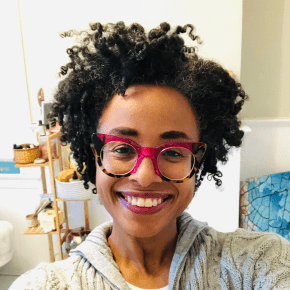A Reflection from the Interviewer, Maati Wafford, AMS Director of Equity and Engagement
One great strength of the U.S. Montessori community is the number of public Montessori schools which offer a free-tuition option for families to access Montessori education. Yet just because a public Montessori school is free does not always mean it is accessible or representative of the surrounding community. According to publicly available data as of a 2016 study, a significant number of public Montessori schools are whiter and serve a more affluent population of students than their surrounding districts and neighborhoods that are disproportionately economically disadvantaged and home to predominantly families of color.
AMS has committed to continuously stretching its members, accredited schools, teacher training programs, and itself as an organization. As declared in its newly institutionalized anti-bias, antiracist statement, AMS is “dedicated to interrogating and investigating past practices, recognizing, addressing, and eradicating all current forms of racism and systemic oppression within the organization, and supporting members in doing the same in their schools, programs, and practices.”
As director of equity and engagement at the American Montessori Society, my job is to grapple with the policies that continue to marginalize students and families and how we can best position ourselves as educators and leaders to actively liberate and bring justice to the inequities that we see.
In order to gain perspective on how the Montessori community can effectively address these inequities, I sat down with sociologist Dr. Mira Debs of Yale University who is the author of Diverse Families, Desirable Schools: Public Montessori in the Era of School Choice (Harvard Education Press) and co-editor of the Handbook of Montessori Education (Bloomsbury, 2023). She researches school integration, school choice, and parent involvement in the United States and internationally.
Mira, can you please share more about the unequal landscape within which many of our public Montessori schools are situated? What questions do school leaders need to ask in order to root out injustice in their districts and institutions?
Part of the reason I wrote a book on public Montessori is that I wanted the broader public to know that public Montessori exists so widely in the United States. I’m inspired by the fact that so many of these schools were created as part of desegregation court orders and have missions of serving a racially and socioeconomically diverse student population.
At the same time, as I started digging into the student data of public Montessori schools, I was sometimes surprised by how different the student enrollments looked compared to the surrounding district. In some cases, the public Montessori school was offering a racially and socially diverse school environment in a very segregated school district. But in other cases, the public Montessori school was contributing to the broader segregation in the district by enrolling a disproportionately white and wealthy student body. Conversations with school leaders in the course of conducting my research revealed that a number of them were concerned about the displacement of families of color or their sense of comfort in the school. In some of cases, the school started with a lot of families of color and had grown more white and affluent as the school became desirable (hence the title of my book).
There are a number of things contributing to segregation and displacement in public Montessori schools. As a researcher on school choice, we know that any time parents are asked to choose a school, there is a selection effect that favors parents with resources, such as the time to research schools, attend school choice events, and navigate complicated enrollment systems. To whatever extent this is district policy, outside of the control of schools, school staff must work to provide outreach and information to families to ensure that families with more limited resources can find out about the school.
I’ve also been struck to learn that some public Montessori schools have policies in place that limit the number of children from low-income backgrounds who enroll. For example, they do not provide transportation or free lunch to students. Other public Montessori schools charge attendance for preschool if there is no state funding for it, before families can access the public Elementary program. Others enroll children on a first come first served basis rather than using a lottery system. All of these policies make it hard for some families to enroll in the school and tips school enrollment into wealthier or whiter student populations. These are practices that must be changed.
Finally, another key issue is around how school staff communicates to prospective families about Montessori. For families coming from backgrounds that have historically been denied educational opportunities, it’s really critical for them to know that the school they are choosing is one that will guarantee the academic success of their child. When Montessori educators don’t explicitly discuss academic results or say that they think this isn’t important, or that we let children be in charge of their learning, this can make choosing Montessori feel like a risky choice. What is the data on the performance of students of color and students from low-income backgrounds in your school? How are you communicating about the academic success of students in your program?
My book on public Montessori also compiles an appendix of best practices around enrolling a diverse student body sharing what I learned from a number of public Montessori schools.
From all that you have and continue to learn from your policy work and research, what homework would you give Montessori leaders and educators? In other words, what do we need to know? How do we equip ourselves for further advocacy in this area?
There’s great information on supporting racially diverse public schools through subscribing to the mailing list of organizations like the National Coalition for School Diversity and Integrated Schools.
As a community, we have a tremendous amount of work to do to change both the perception and the reality on the ground to make Montessori accessible to children of all backgrounds. There is a very strong perception that Montessori education is elite and is maybe only recently starting to change. My research, both on public Montessori and global Montessori, has shared the stories of many pioneering non-white Montessori educators who in many cases were foundational to creating public or accessible Montessori programs in their communities. I’m thinking of Dina Paulik in Dallas, TX; Martha Urioste in Denver, CO; Juliet King and Lucy Canzoneri-Golden in Miami, FL; Ana Maria Garcia Blanco in Puerto Rico; the late Mae Arlene Gadpaille in Boston, MA; and the late Roslyn Williams in New York, NY. It’s been gratifying to see how learning of these Montessori ancestors and elders have been empowering to contemporary Montessori BIPOC (Black, Indigeneous, and people of color) leaders. Who today is doing extraordinary work in this space that you can learn from?
But we also see instances where Montessori was used as part of systems of repression: the Native American boarding schools system in the U.S. in the 1910s, missionaries in Africa in the 1920s who described Montessori education as a “redemption of the natives,” and by Maria Montessori collaborating with Mussolini in Fascist Italy. These accounts remind us that Montessori educators are not blameless. They reflect the racism and political environment surrounding them. In celebrating Montessori education, we should learn and teach an honest appraisal of what it has been in the past and where it stands now in the present.
It’s especially important that Montessori training includes a historical study of the movement, both globally and in the United States. We’ve written both Diverse Families, Desirable Schools: Public Montessori in the Era of School Choice (Harvard Education Press) and the Handbook of Montessori Education (Bloomsbury, 2023) in a format to be accessible to an audience of Montessori teachers in training and families.
Finally, as school leaders, I would ask you to continually ask yourself, your team and your parents to be attentive to who is present and who is missing? If certain populations are not represented, why not, and how can you change it?
About the Author
 The opinions expressed in Montessori Life are those of the authors and do not necessarily represent the position of AMS. |


